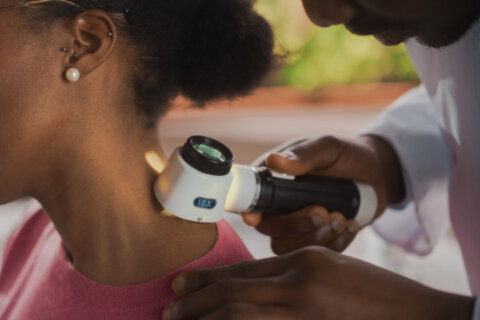With all the unknowns surrounding a cancer diagnosis, patients and their families face uncertainties while oncologists continue to search for ways to learn more about each patient’s particular cancer.
While treatments of solid tumors generally include frequent CT, PET and MRI scans, to look for suspicious lesions, which can lead to a tissue biopsy, new treatments allow oncologists to detect tumor cells and cancer cell DNA before anything is visible on a scan.
Dr. Julie Gralow, chief medical officer of the American Society of Clinical Oncology, tells WTOP liquid biopsies, conducted through a blood draw, are playing a role in detecting and treating gastrointestinal cancers of the colon, stomach and liver, as well as genitourinary cancers of the prostate, kidney and bladder.
As a tumor grows, pieces can break off and circulate in the bloodstream, which can spread to other parts of the body, according to the National Cancer Institute. When cancer spreads to organs other than where it originated, that’s called metastatic, or stage 4 cancer.
The liquid biopsy looks for circulating tumor DNA, or ctDNA, Gralow said.
“Little bits of DNA get sent out into the bloodstream from the cancer cell, as it divides, as it grows, as it dies,” Gralow said. “So, that’s a way of monitoring ‘is there cancer in the body, is it shedding something into our blood?'”
When many cancers are detected early, surgery is often the method used, with the intent of a cure. However, cancers of any stage — 1, 2, 3 or 4 — can return.
One recent clinical trial of liquid biopsies for colon cancer patients provided important information, according to Gralow.
“Monitoring colon cancer after definitive surgery is predictive,” Gralow said. “If you find evidence that there is some tumor DNA, if you’re following the colon cancer patient over time, it is predictive of an eventual obvious recurrence, where you can see where the tumor is.”
Another trial looked at how doctors might use the discovery of ctDNA as the impetus to begin treatment. Gralow said the patients had been diagnosed with stage 2 colon cancer and had surgery.
“These were colon cancer patients that were felt to be low risk, and they didn’t need chemo,” Gralow said. “If they started seeing circulating tumor DNA, then they would start chemo.”
However, Gralow said the trial was stopped because it wasn’t helping patients involved in the trial.
“Adding the chemo at that time point, when you could start to see the ctDNA, actually didn’t change the outcome. It didn’t clear (the ctDNA).”
Even though the trial wasn’t completed, Gralow said researchers learned more about the presence of ctDNA.
“While we know it’s predictive, that it means there’s some cancer, knowing what to do at that time point, we need better treatments,” Gralow said. “It’s not just starting chemo at that time point, because in this study, that did not help the patient or change the outcome.”
Get breaking news and daily headlines delivered to your email inbox by signing up here.
© 2024 WTOP. All Rights Reserved. This website is not intended for users located within the European Economic Area.








